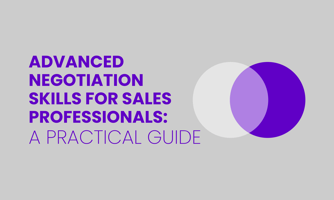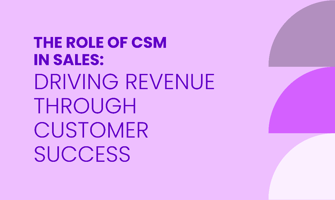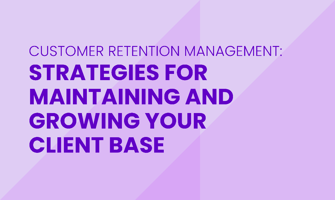Sales professionals need strong negotiation skills to close deals and build relationships with...
Customer Success Reporting: Essential Dashboards and Analytics
Understanding customer success can help improve how customers use your product.
Customer success reports show how well you're doing in keeping customers happy. They also show if customers are using your product effectively.
These reports often include:
Revenue metrics
Customer satisfaction
Onboarding stats
They help you track progress toward company goals. They also help you understand customer feedback.
Learn how to use different types of dashboards and analytics. These tools can help you create detailed reports to guide your strategies.
Table of Contents
The Table of Contents includes sections like:
Revenue Metrics
OKRs Progress
Product Feedback
CSAT
New Customer Onboarding
Subsections cover specifics such as:
Monthly Recurring Revenue (MRR)
Expansion MRR
Churn Metrics
Customer Health Scores
An organized Table of Contents helps users quickly find data on:
Customer success
Onboarding efforts
Revenue performance
For a VP of Sales or CEO, navigating reports becomes easy. They get access to detailed metrics on:
Expansion
Churn rates
Dashboards show metrics like:
Net Revenue Retention
Net Promoter Score
These help success teams make informed business decisions.
Customer support tickets, onboarding details, and customer feedback summaries are also easily accessible. This can improve customer loyalty and guide the success team in targeting growth strategies.
Subsections ensure that every part, from churn to customer satisfaction, is well covered. This makes it easier for boards and stakeholders to evaluate customer success campaigns and initiatives.
This structured approach enhances how businesses track customer experience. It also affects the overall success and development of SaaS businesses.
Customer Success Reporting Overview
Customer success reporting should include KPIs like MRR, Expansion MRR, customer churn, and Net Revenue Retention. These metrics help businesses understand revenue growth and how well onboarding efforts are going.
Reports can show customer feedback and qualitative feedback. This helps the success team improve customer satisfaction and retention. By looking at customer health scores and Net Promoter Scores, they can see how customers feel and how loyal they are. This helps build stronger relationships.
Tools like dashboards and emails can show data to the CEO, VP of Sales, and the board. This helps them make informed business decisions. Success teams should also look at the performance of campaigns and interactions, including customer service tickets. This helps manage existing customers and predict renewals.
SaaS businesses benefit from detailed monthly reports. These reports reflect the impact of strategies on customer success and growth. Reports aligned with company goals lead to actionable insights. This enhances customer support and onboarding, driving long-term success.
Essential Dashboards for Customer Success Reporting
Success Metrics Dashboard
The Success Metrics Dashboard should have the following KPIs:
Monthly Recurring Revenue
Expansion MRR
Churn
Net Revenue Retention (NRR)
Customer Health Score
Net Promoter Score (NPS)
Customer retention rates
It should also include customer support metrics, such as:
Tickets resolved
Average resolution time
Customer Satisfaction (CSAT) scores
The dashboard should be updated bi-weekly for some metrics and monthly for others.
Best practices for visualization include using bar charts, donut charts, and line graphs. These help show progress towards company goals and OKRs.
Interactive elements let team members explore specific metrics deeply. This includes Customer Success Managers (CSMs), VPs of Sales, and the CEO.
Some practical examples are:
Tracking onboarding progress to improve customer experience
Analyzing customer feedback from emails and surveys to enhance customer service
These visuals help the team make informed decisions and plan for revenue growth and customer loyalty campaigns.
This approach helps SaaS businesses measure their success efforts and use resources effectively to increase customer satisfaction and retention.
Customer Support Dashboard
The Customer Support Dashboard tracks important performance indicators. These include Net Revenue Retention , Monthly Recurring Revenue , Customer Health Score, Net Promoter Score, churn rate, and customer satisfaction scores.
It also shows metrics on revenue, expansion MRR, and customer feedback. The data updates regularly, often bi-weekly or monthly. This keeps it aligned with company goals.
Team members, like the VP of Sales and the CEO, can customize their views. This helps them focus on customer retention, onboarding, or support tickets. It aids in making business decisions to improve customer experience and loyalty.
By analyzing feedback and tracking performance through the dashboard, success teams can drive customer growth and retention. The dashboard helps in monitoring relationships, emails, and the overall health of the customer base.
Customizable views allow for deep dives into specific data. This helps in achieving business objectives and improving customer service and support.
Key Customer Success Metrics to Track
Customer Health Score
The customer health score measures how engaged and satisfied customers are with a product or service.
It is calculated using various metrics:
Monthly recurring revenue
Customer churn rate
Net revenue retention
Customer satisfaction
Qualitative feedback
Expansion MRR
Customer feedback from surveys
When a low score is detected, the success team might start campaigns or send targeted emails to improve customer experience.
High scores could lead to starting new customer onboarding or focusing on current customer loyalty.
This score is often reviewed and updated in reports, which can be monthly or quarterly.
These reports include dashboards showing performance metrics for the business.
They help the CEO, VP of Sales, and board make informed business decisions.
By analyzing the data, success efforts are aligned with the company goals.
This aims for sustained revenue growth and customer retention.
Good reporting on customer health scores can affect the success team's strategies, customer service, and overall relationship management, driving growth for SaaS businesses.
Net Promoter Score
Net Promoter Score measures customer loyalty and satisfaction. It asks how likely customers are to recommend a product or service on a scale from 0 to 10.
NPS is calculated by subtracting the percentage of Detractors (0-6 scores) from the percentage of Promoters (9-10 scores). This score helps Customer Success Managers understand customer experience and make better decisions.
Customer feedback through NPS can improve onboarding and support. For SaaS businesses, a high NPS means strong customer relationships and retention. This affects monthly recurring revenue and customer retention.
Tracking NPS in dashboards and reports helps VPs of Sales and CEOs align success with company goals. It drives revenue growth and improves customer loyalty.
Analyzing NPS with other feedback and scores helps businesses meet customer needs. This reduces churn and improves customer satisfaction. It also influences metrics like expansion MRR and ARR.
Regular NPS reporting to the board allows the CEO to make informed decisions. This helps create better customer relationships.
Customer Churn Rate
Customer churn rate shows the percentage of customers who stopped using a product or service over a set time.
It affects SaaS businesses' revenue and net revenue retention. This impacts company goals.
In customer success reports, churn rate data is tracked to understand changes over past periods. Reports include metrics like:
Customer health score
Net promoter score
Monthly recurring revenue
These metrics provide insights for the success team and VP of sales.
Primary reasons for customer churn include poor customer support, ineffective onboarding, and unmet customer expectations.
To reduce churn, the success team focuses on:
Improving customer experience
Responding swiftly to customer feedback
Enhancing customer service
Expansion MRR and customer loyalty are closely monitored using dashboards and customer satisfaction emails. Customer success managers track onboarding efforts and customer feedback through tickets and campaigns to ensure customer retention.
Reporting tools reflect these metrics, helping the CEO make informed business decisions.
This focus on customer relationships and retention leads to better performance and growth for the customer base.
Monthly Recurring Revenue
Monthly Recurring Revenue trends show how a business is doing over time.
Over the past year, MRR trends have changed due to:
Customer retention
Onboarding
Customer experience
A big part of MRR comes from renewals of existing customers. This shows customer satisfaction and loyalty. The rest comes from new customer campaigns and onboarding.
Comparing current MRR to the target helps see if efforts like customer support and customer success are meeting company goals. Dashboards and reports shared with the CEO and VP of Sales highlight this data for business decisions.
For SaaS businesses, focusing on expansion MRR or reducing churn can lead to more MRR growth. This directly affects overall revenue growth and retention metrics. Customer feedback through customer health scores and net promoter scores can further refine these reports.
Customer Lifetime Value
Customer Lifetime Value (CLV) estimates the total revenue a customer brings to a business over their relationship.
Key factors include:
Monthly Recurring Revenue
Customer retention rates
Customer support costs
Customer churn rates
To increase CLV, customer success teams can:
Focus on great onboarding
Run tailored email campaigns
Provide proactive customer support
Collect customer feedback
These steps boost customer satisfaction and retention. This can help grow the customer base.
Understanding CLV helps SaaS businesses and VPs of Sales make smart decisions. They can see where to allocate resources and which metrics to emphasize. They can also see how to improve the customer experience.
Reports and dashboards can track performance. Strategies like tracking Net Promoter Scores or Customer Health Scores help find loyal customers and spot areas needing improvement.
Align CLV insights with company goals to drive revenue growth. This shows the impact of customer success in meetings and other reports.
Customer Retention Cost
Customer Retention Cost is the total amount the success team spends to keep current customers within a certain time frame.
This includes:
Customer support
Onboarding campaigns
Emails aimed at improving satisfaction and loyalty
Metrics used to track the impact include:
Monthly Recurring Revenue
Net Revenue Retention
Customer Health Score
Net Promoter Score
Customer retention affects profitability by reducing churn and increasing revenue from expansion MRR.
For example, SaaS businesses use dashboards to report retention rates and customer feedback to leaders like the CEO, VP of Sales, and the board.
Effective strategies include:
Personalized customer service
Resolving customer support tickets quickly
Gathering qualitative feedback through surveys
These efforts improve customer experience and satisfaction, aligning with company goals and driving sustainable revenue growth.
Proper analysis and reporting help make business decisions that support customer success and retention objectives.
Customer Satisfaction Score
Customer Satisfaction Score is measured by asking customers about their experience with a product or service.
These surveys can ask about:
Customer support interactions
Onboarding processes
Overall satisfaction
Results are analyzed and updated regularly. This may happen monthly or quarterly to ensure accurate data.
The success team uses this data to identify trends and areas for improvement. For example, if CSAT shows a drop-in satisfaction, the company may offer extra training for customer service reps or improve onboarding content.
This information helps the CEO and VP of Sales make smart business decisions. They use CSAT along with other metrics like:
Net Revenue Retention
Customer Health Score
Expansion MRR
Qualitative feedback
By looking at all these metrics, businesses can tailor their reports and find specific ways to boost revenue growth and performance. Continuous analysis helps keep customers loyal, reduces churn, and strengthens relationships, aiding overall growth and success.
Renewal Rate
To understand renewal rates, we need to compare them to previous periods. Businesses often track this with dashboards and reports.
Success teams can improve renewal rates by analyzing monthly recurring revenue and net revenue retention. Data shows renewal rates vary across customer segments. Factors such as effective onboarding campaigns and customer health scores from surveys and feedback influence these rates.
For example, SaaS businesses find that higher customer satisfaction and loyalty, measured by the Net Promoter Score , lead to better renewal rates. Customer support effectiveness, seen through the number of resolved tickets, and positive relationships with customer success managers, also influence renewal rates.
Economic conditions or changes in the product or service can impact expansions and churn. Aligning renewal rate goals with company objectives helps vp of sales and CEOs make informed decisions for customer retention and growth.
Customer feedback and performance data from emails and campaigns allow success teams to tweak their strategies. This leads to better results across all customer segments.
Utilizing Qualitative Customer Feedback
You can gather customer feedback through:
Surveys
Support tickets
Direct emails
For example, surveys ask what customers like or dislike about a product or service. This can help improve onboarding and customer experience.
Customer success managers should group feedback into themes like usability, features, or support. Dashboards can report these insights. Analyze this data to find common issues and trends among customers.
Use this feedback to improve areas like expansion MRR and customer health scores. This is important for SaaS businesses. It helps success teams and the VP of Sales align campaigns with company goals. This can reduce churn and boost retention.
Reports should show how feedback affects key metrics like net revenue retention and monthly recurring revenue. The success team can discuss these insights during weekly meetings. This helps the CEO and VP of Sales make better decisions.
Qualitative feedback can boost customer satisfaction, loyalty, and revenue. It directly impacts product development and customer support efforts.
Visualizing Customer Success Achievements
To use data visualization tools effectively, the team can display key customer metrics using dashboards. These dashboards can show revenue growth, customer onboarding rates, and retention details.
For presenting customer milestones and KPIs, align reports with company goals. Use practical visuals like donut or bar charts to track progress towards OKRs.
Visual elements such as graphs and infographics can highlight metrics like:
Monthly Recurring Revenue
Net Revenue Retention
Expansion revenue
Customer health scores
Charts illustrating customer churn, ticket resolutions, customer satisfaction , and Net Promoter Score can also help SaaS businesses.
Reports should focus on details that impact business decisions, such as customer feedback and expansion MRR. By tracking these success efforts, companies can improve customer loyalty and achieve growth targets.
Success teams and Customer Success Managers can use these visual tools in weekly meetings. This helps celebrate successes and plan future campaigns.
Presenting this data visually to the VP of Sales, CEO, or other leaders ensures success efforts are clear. This enhances customer experience and loyalty.
Optimizing Customer Success Efforts with Analytics
Analytics can help track important metrics like monthly recurring revenue , expansion MRR, and customer health scores. This helps businesses see patterns and trends in customer behavior.
By analyzing this data, companies can learn how customers use their product or service. For example, dashboards can show high churn rates among new customers. This signals a need for better onboarding.
Predictive analytics can forecast customer churn by using customer feedback to identify at-risk accounts. This allows the success team to take action to improve customer retention.
Customer success teams can look at customer service tickets, Net Promoter Scores , and customer satisfaction rates. They can then tailor support and engagement plans. These plans can deliver campaigns and emails that meet specific customer needs, improving the overall customer experience.
Sales VPs and CEOs can make informed decisions and align customer success efforts with company goals. This can lead to revenue growth.
Reports can show the impact of these efforts on net revenue retention and customer loyalty. This supports growth and expansion for SaaS businesses.
FAQ
What are the key metrics to include in a customer success reporting dashboard?
Key metrics to include in a customer success reporting dashboard are customer satisfaction scores, customer retention rate, net promoter score , customer health score, and usage metrics like product adoption and engagement rates.
How can customer success reporting help improve customer retention rates?
Customer success reporting can help improve customer retention rates by identifying trends, tracking customer engagement, and providing insights for personalized communication and support.
For example, tracking usage data can highlight areas where customers may need additional assistance, leading to proactive outreach and increased customer satisfaction.
What are some common challenges faced when creating customer success reports?
Common challenges faced when creating customer success reports include collecting accurate data, determining relevant key performance indicators (KPIs), and effectively communicating insights to stakeholders.
For example, ensuring data quality, selecting metrics aligned with business goals, and presenting findings in a clear and concise manner can all pose obstacles in report creation.
What is the importance of using analytics in customer success reporting?
Analytics in customer success reporting are crucial for tracking key metrics and trends, identifying areas of improvement, and making data-driven decisions to enhance customer satisfaction. For example, analyzing customer engagement data can help prioritize efforts and tailor strategies for improved outcomes.
How often should customer success reports be reviewed and updated?
Customer success reports should be reviewed and updated on a regular basis, ideally monthly or quarterly. This frequency allows for timely insight into customer satisfaction, helps identify trends, and enables adjustments to be made in a timely manner.




